In the windswept land of Cappadocia, where the earth’s ancient secrets whisper through the valleys, lies a hidden treasure: a story of clay transformed into art. Here, the art of pottery making has thrived for centuries, weaving tales of creativity and skill passed down from generation to generation.
As the sun rises over the rugged landscape, illuminating the red clay found only in this region, a vibrant world of historical pottery comes to life. But what secrets lie within the delicate vessels, intricately crafted by the hands of Cappadocian artisans? What stories do they tell, and what significance do they hold?
Journey into the heart of this ancient art form and uncover the captivating history of pottery making in Cappadocia.
Good To Know
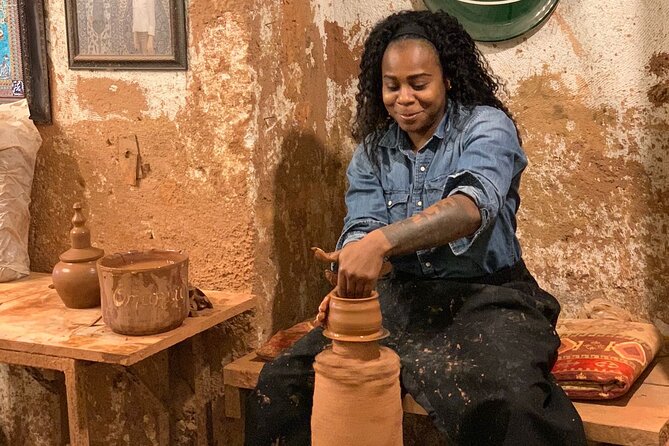
- Pottery in Cappadocia has a long history dating back to the Hittites and has been used for storage, cooking, and religious rituals.
- Cappadocian pottery is influenced by various cultures and is shaped by the unique geological formations and clay deposits in the region.
- Traditional firing methods such as pit firing and kiln firing contribute to the distinct beauty and craftsmanship of Cappadocian pottery.
- The evolution of pottery styles in Cappadocia showcases the ingenuity and creativity of artisans, resulting in vibrant colors, intricate detailing, and unique forms.
Origins of Pottery in Cappadocia
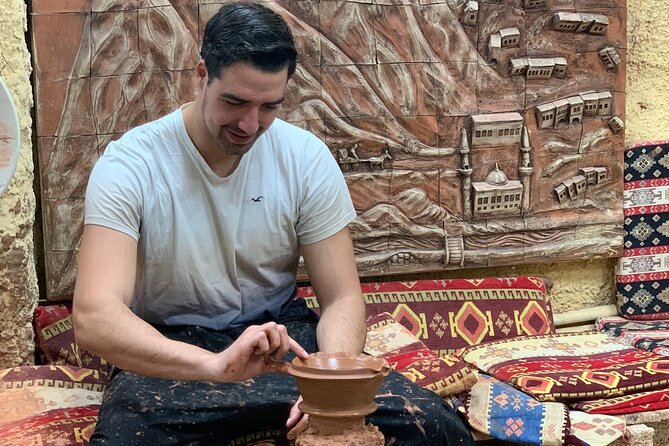
The origins of pottery in Cappadocia can be traced back to ancient civilizations that inhabited the region thousands of years ago. The art of pottery in Cappadocia dates back to the Hittites, who were one of the earliest civilizations to settle in the region. They were skilled potters and used pottery for various purposes, including storage, cooking, and religious rituals. Over the centuries, pottery making techniques evolved and were influenced by various cultures, such as the Persians, Greeks, and Romans.
Cappadocia, with its unique geological formations and abundant clay deposits, provided the perfect environment for the development of pottery making. Pottery played a significant role in Cappadocian culture, not only as a functional item but also as a form of artistic expression. Intricate designs, vibrant colors, and unique shapes were often incorporated into the pottery, reflecting the creativity and craftsmanship of the Cappadocian people.
Today, the tradition of pottery making is still alive in Cappadocia. Local artisans continue to produce exquisite pottery using traditional techniques passed down through generations. Visitors can explore pottery workshops and witness the skill and dedication that goes into creating these beautiful works of art.
Interested in history? More Goreme historical sites we've covered
Ancient Pottery Techniques
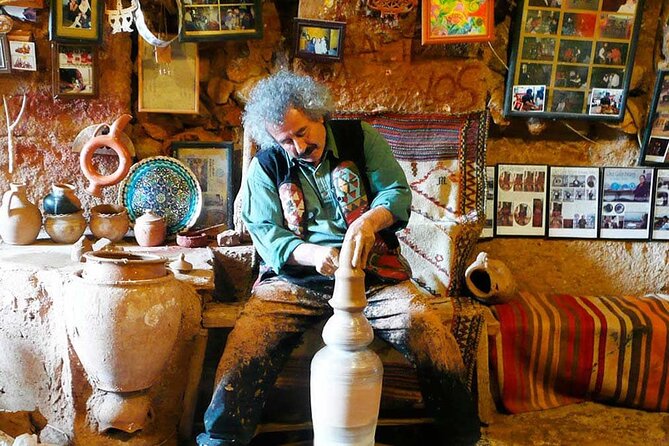
With a rich history dating back to the ancient civilizations of Cappadocia, the art of pottery has been shaped by a myriad of ancient techniques that continue to inspire and captivate artisans and visitors alike.
One of the most fascinating aspects of ancient pottery is the traditional firing methods used by the potters. These methods, such as pit firing and kiln firing, have been passed down through generations, ensuring the preservation of ancient pottery techniques.
Pit firing involves burying the pottery in a pit and firing it with wood or other combustible materials, creating unique and unpredictable patterns on the surface.
Kiln firing, on the other hand, involves placing the pottery in a kiln and subjecting it to high temperatures, allowing for greater control over the final result.
Both methods contribute to the distinct beauty and craftsmanship of Cappadocian pottery, making it a cherished art form that continues to thrive today.
Significance of Cappadocian Pottery

Cappadocian pottery, steeped in ancient traditions and craftsmanship, holds a significant place not only in the region’s history but also in the hearts of those who appreciate its unique beauty. This pottery is not just a mere collection of clay pots; it represents a rich cultural heritage and serves as a testament to the skill and creativity of the artisans who crafted them. These historical artifacts tell stories of the past, reflecting the customs, beliefs, and daily lives of the people who lived in Cappadocia centuries ago. The cultural importance of Cappadocian pottery cannot be overstated. It serves as a link between the present and the past, allowing us to connect with our ancestors and gain a deeper understanding of their world. Through its intricate designs and exquisite craftsmanship, Cappadocian pottery continues to captivate and inspire people around the world.
| Cultural Importance | Historical Artifacts |
|---|---|
| Connects with past | Reflection of customs |
| Link to ancestors | Represents beliefs |
| Appreciation of art | Daily life depiction |
| Showcases heritage | Tells stories |
| Inspires creativity | Captivates viewers |
Evolution of Pottery Styles
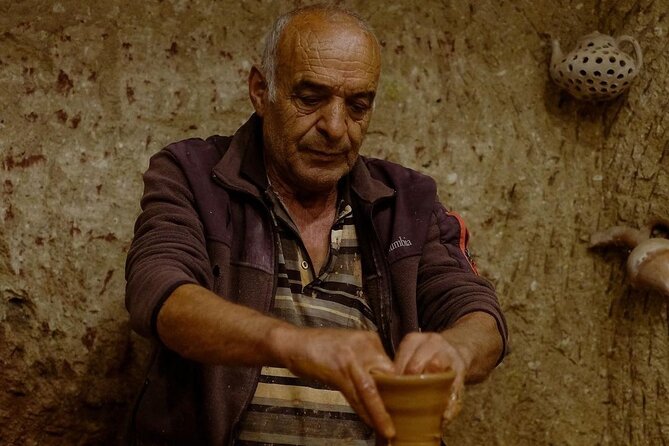
Throughout the centuries, pottery styles in Cappadocia have evolved, showcasing the ingenuity and adaptability of the artisans who’ve shaped this craft.
The evolution of pottery techniques in Cappadocia can be traced back to its rich historical pottery traditions. In the early days, simple clay pots were created using rudimentary methods. As time went on, the artisans began experimenting with different shapes, sizes, and designs. They incorporated intricate patterns and motifs, reflecting the cultural influences of the region.
With the introduction of the potter’s wheel, new possibilities emerged, allowing for more delicate and precise craftsmanship. Today, Cappadocian pottery is known for its vibrant colors, intricate detailing, and unique forms. It’s a testament to the skill and creativity of the artisans who continue to push the boundaries of this ancient craft.
Famous Cappadocian Pottery Artists
As the pottery styles in Cappadocia have evolved throughout the centuries, a number of talented artists have emerged, leaving their mark on this ancient craft. These famous Cappadocian pottery artists haven’t only mastered the traditional pottery making techniques, but have also innovated and introduced their own unique styles to the art form.
Some of the renowned artists include:
Mustafa Düzgün: Known for his intricate hand-painted designs, Mustafa Düzgün has gained international recognition for his exquisite pottery pieces. His attention to detail and mastery of the famous pottery techniques of Cappadocia have made him a sought-after artist.
Ayşe Şener: Ayşe Şener is celebrated for her ability to breathe life into her pottery creations. She skillfully combines traditional pottery making traditions with modern aesthetics, resulting in stunning and contemporary pieces.
Mehmet Güney: Mehmet Güney is known for his exceptional craftsmanship and his ability to create pottery pieces that tell stories. His work often features intricate carvings and symbols, reflecting the rich history and culture of Cappadocia.
These famous Cappadocian pottery artists haven’t only preserved the legacy of pottery making in Cappadocia, but have also pushed the boundaries of the art form, making it a vibrant and thriving tradition in the region.
- Valleys and Landscapes of Cappadocia Guided Tour With Lunch – Goreme
- The Best Sunset Horseback Riding Tours in Cappadocia
- Sunset ATV Tour in Cappadocia(Quad Bike Tour)
- Quad Safari Through Rose Sword and Love Valleys
- Whirling Dervishes Show in Cappadocia With Hotel Pick up
- Two Hour Horse Tour Cappadocia.(Economic Sunrise, Sunset and Any Timeofthe Day
Pottery Making Workshops in Cappadocia
Visitors to Cappadocia can enjoy the rich tradition of pottery making through engaging and hands-on workshops. These workshops offer a unique opportunity to learn about the pottery making techniques and experience the pottery making process firsthand.
Participants will have the chance to work with skilled artisans who’ll guide them through each step of creating their own pottery masterpiece. From shaping the clay to adding intricate designs, these workshops provide a glimpse into the artistry and craftsmanship that goes into creating Cappadocian pottery.
Whether you’re a beginner or have some experience with pottery making, these workshops cater to all skill levels. It’s a truly rewarding experience to witness the transformation of a lump of clay into a beautiful piece of art.
Common Questions
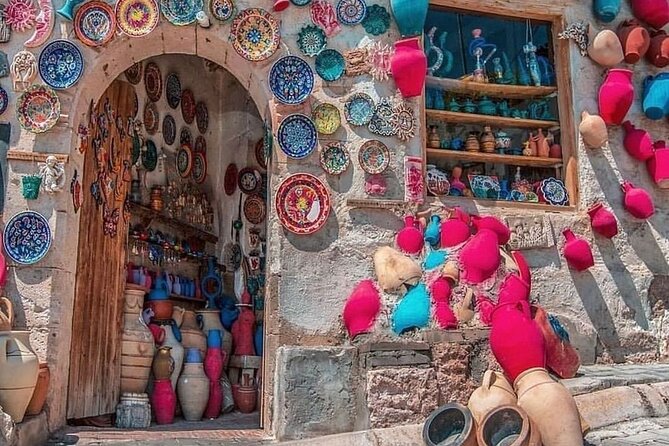
What Are the Different Types of Clay Used in Cappadocian Pottery?
In Cappadocian pottery making, different types of clay are used, each with its unique properties. The techniques and tools employed by artisans allow them to shape and mold the clay into beautiful and functional pottery pieces.
How Long Does It Take to Complete a Pottery Piece in Cappadocia?
In Cappadocia, the pottery making process is not rushed. It takes time to create a pottery piece, as artisans carefully shape and design each piece by hand. This attention to detail reflects the cultural significance of pottery in the region.
Are There Any Specific Symbols or Motifs That Are Commonly Found in Cappadocian Pottery?
There are several symbols and motifs commonly found in Cappadocian pottery that hold cultural significance. These designs have been influenced by the region’s rich history, showcasing the unique artistic heritage of the area.
Can Visitors Participate in Pottery Making Workshops in Cappadocia?
Visitors to Cappadocia can participate in pottery making workshops. They will have the opportunity to experience the pottery making process firsthand and learn from skilled artisans. It’s a hands-on experience that allows visitors to unleash their creativity.
Are There Any Traditional Techniques or Tools That Are Unique to Cappadocian Pottery Making?
Traditional pottery making in Cappadocia employs unique techniques and tools. Skilled artisans use age-old methods to shape clay into beautiful creations, showcasing the region’s rich cultural heritage. These techniques and tools contribute to the distinctive beauty of Cappadocian pottery.
The Sum Up
As the sun sets over the enchanting region of Cappadocia, the legacy of pottery making continues to thrive.
From its humble beginnings to the intricate techniques passed down through generations, pottery has captured the hearts and imaginations of both locals and visitors alike.
The significance of Cappadocian pottery lies not only in its artistic beauty, but also in its reflection of the region’s cultural heritage.
As we bid farewell to this captivating journey, we’re reminded of the timeless allure and enduring spirit of historical pottery making in Cappadocia.
More Historical Tours in Goreme
More Tour Reviews in Goreme
- Full Day Cappadocia Tour( Red Tour + Underground City )
- Balloon Flight Over Cappadocia the Unforgettable Sky Adventure
- Best of 1,2,3 or 4-Day Cappadocia Tour/Private Car+Licensed Guide
- Cappadocia Classic Vintage Car Tour 2 hours
- Cappadocia All nclusive Private Mix Tour
- Cappadocia Best Private Full Day Tour
Looking for something different? Other Goreme activities we've written about
- Full Day Cappadocia Tour( Red Tour + Underground City )
- Balloon Flight Over Cappadocia the Unforgettable Sky Adventure
- Best of 1,2,3 or 4-Day Cappadocia Tour/Private Car+Licensed Guide
- Cappadocia Classic Vintage Car Tour 2 hours
- Cappadocia All nclusive Private Mix Tour
- Cappadocia Best Private Full Day Tour
- Kayseri ASR or Nevsehir NAV Airport Shared Shuttle Service
- Cappadocia Horseback Riding
- Cappadocia Hot Air Balloon Over Goreme Valley
- Hot Air Balloon Ride at Sunrise in Goreme, Cappadocia
- Cappadocia Hot Air Balloon Flight with Video
- Cappadocia Dervishes Ceremony
